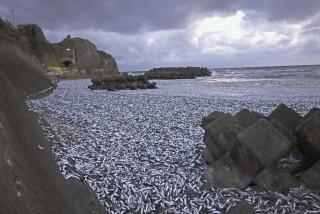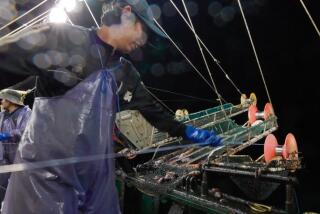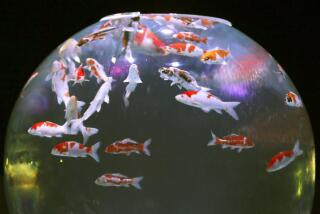Japan’s appetite for fish is depleting stocks, threatening restaurants
- Share via
Reporting from Tokyo — Business is brisk at the Aburi Itsu restaurant, a great relief for fifth-generation owner Michimasu Takayasu. The reason: The eatery specializes in eel, or unagi.
The fish is hugely popular in Japan, especially in hot weather, when the delicacy is believed to boost sagging energy.
Dishes are prepared by chefs specially trained in eel cooking: They scoop the squirming fish out of restaurant tanks, deftly slice off the heads, soak the rest in a soy sauce mixture and broil it to perfection over hot coals.
But the island nation’s voracious appetite for eel and other fish has depleted the ocean’s supplies and raised international outcries to halt Japan’s overfishing.
“Each year is a fight for survival,” Takayasu said.
Dramatically lower eel catches from local river habitats have led to an overwhelming dependency on expensive fish farms and imports, forcing restaurants like Takayasu’s out of business.
Last year, for instance, eelers caught 267 tons from natural habitats, a drop of two-thirds from the amount caught a decade earlier, according to the Nihon Yoshoku Shinbun, a publication that tracks marine resources. Last year’s catch was less than 1% of the nearly 35,000 tons consumed; farming provided nearly 11,000 tons, and imports from China and Taiwan accounted for the remainder, the publication said.
Industry experts have criticized the quality of imports as uneven and have noted that cultivating eels on about 300 fish farms nationwide is a high-risk, labor-intensive venture.
“The sad story of Japanese unagi is just one of the many examples of how Japan’s voracious appetite for fish has created problems for itself,” said Hiroyuki Matsuda, eel resource researcher at Yokohama National University.
Low counts of other fish, along with a dwindling, aging group of fishermen — the average age is now over 60 and their numbers are shrinking an average of 5% a year — have threatened the industry and the livelihoods of those who depend on it.
The Fisheries Agency of Japan said the market for domestic fish in 2008 dropped to $11.7 billion, down more than one-third from $18.8 billion a decade earlier, based on current exchange rates. The agency also has warned that half of the marine resources in the waters surrounding Japan have dropped drastically in the last two decades.
For example, less than 20,000 tons of horse mackerel, a fish widely eaten because of its affordable prices, is caught annually, down from 70,000 tons in 1991. And Pacific saury, a fall delicacy, is now fetching as much as $8 a fish — eight times as much as two years ago.
The government agency attributed the low catches to rising sea temperatures that are affecting spawning and growth of fish and to overfishing.
Matsuda and other experts said there is no time to lose in instituting major changes to help the Japanese fishing industry survive, and the government needs to lead the way.
“There must be a fundamental change in thinking,” he said, pointing to the need for a fishing policy based on developing grass-roots-level sustainable fisheries.
Takuhira Kaneko, head of Act For, a Fukuoka marine product wholesaler, agrees.
“We need new policies from the government to help us protect resources that can even include cutting down on catches” over the long term, he said.
Seven years ago, Act For started the Mottainai fish project to buy fish discarded from those caught in nets and use them in such products as fish cakes. Mottainai, whose name means “stop wasting,” accounted for $20,000 in sales last year and “helped us to face a business slump due to decreasing catches of popular fish,” Kaneko said.
Wakao Hanaokoa, a tuna expert at environmental group Greenpeace Japan, has called on the government to develop a fishing management system to track endangered species “as a means of ensuring catches are from sustainable sources.”
Such a system, he said, would keep supplies limited and restrict the selling of endangered species, two important steps to protect them.
But such measures are slow in coming.
This November, Japan will host a meeting of pro-whaling nations in Shimonoseki, a southern whaling town. The country’s controversial whaling program harvests about 1,000 whales a year. Tokyo justified the practice by saying the eating of whale meat is a tradition that must be protected.
Japan also faced intense international pressure over fishing for young bluefin tuna in the Pacific, where its catches of 18,000 tons two years ago amounted to 90% of the total.
At a March meeting of the Convention on International Trade in Endangered Species, the Japanese delegation fiercely opposed a proposed ban, which was defeated. Conservationists saw the effort as a means to protect the lucrative sushi market.
Japan’s own fishing for bluefin tuna barely satisfies its appetite. The country imports four-fifths of the expensive Atlantic bluefin every year. A large fish can fetch up to $100,000. CITES is considering a ban based on reports that stocks have declined to 80,000 tons from a peak of 300,000 tons in 1974.
Akihiro Ono, a researcher at the Nihon Yoshoku newspaper, said Japan was trying to balance its responsibility to replenish fish stocks with its need to protect the nation’s traditional marine-based diet.
“The government hopes to continue with measures that will pave the way for sustainable fish catches. Accepting fishing bans is only the last resort,” he said.
But with the dire statistics, fishing industry experts’ consensus is that fish farming is the best solution for now.
Key progress was made in an aquaculture venture at Mie University that successfully raised eels from eggs, the first such experiment in the world. University projects also aim to produce bluefin tuna in captivity.
Still, it would take some time before growing eels from eggs could be turned into a commercial venture. Artificial feed and other expenses would make each eel cost thousands of dollars, experts said.
Takayasu, the restaurateur, worries about the growing expense.
His Chuhei Co. is famous for the Bando taro variety of eel, a local species savored for its succulent meat but no longer found in local rivers.
The eels are cultivated on expensive natural fish feed at two breeding farms in Japan, and annual harvests amounting to about 60 tons are sold to top restaurants in Tokyo.
“Very soon, eating at special eel restaurants like ours might be only for the very rich,” Takayasu said. “That’s not going to do us any good.”
More to Read
Sign up for Essential California
The most important California stories and recommendations in your inbox every morning.
You may occasionally receive promotional content from the Los Angeles Times.










